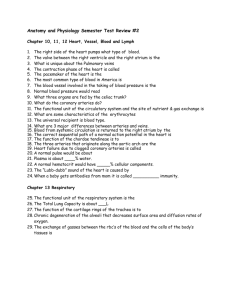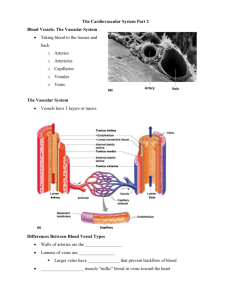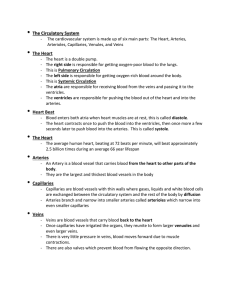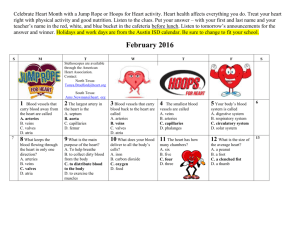Cardiovascular anatomy Ch. 18
advertisement
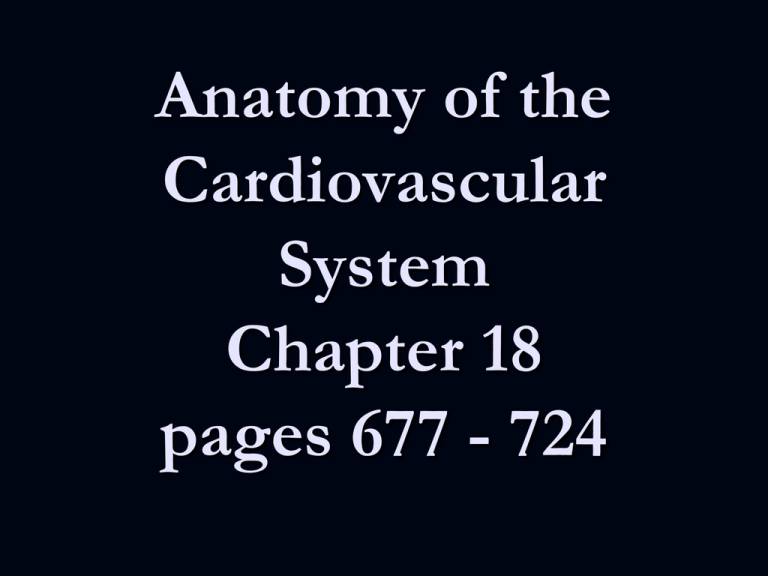
Anatomy of the Cardiovascular System Chapter 18 pages 677 - 724 Heart Location of the heart Lies in the mediastinum ribs 2 through 6 approximately two thirds of its mass is to the left of the midline Apex lies on the diaphragm, pointing to the left Base lies just below the second rib Boundaries of the heart are clinically important as an aid in diagnosing heart disorders Coverings of the heart Pericardium Fibrous pericardium tough, loose-fitting inextensible sac Serous pericardium parietal layer lies inside fibrous pericardium visceral layer (epicardium) adheres to outside of the heart provides protection against friction Layers of the heart Epicardium Myocardium outer layer of heart wall thick, contractile middle layer of heart wall compresses the heart cavities, and the blood within them, with great force Endocardium delicate inner layer of endothelial tissue Chambers of the heart Atria (2) “receiving chambers” because they receive blood from veins Myocardial wall of each atrium is not very thick Chambers of the heart Ventricles “pumping chambers” because they push blood into the large network of vessels Ventricular myocardium is very thick because great force must be generated to pump blood a large distance myocardium of left ventricle is thicker than the right because it must push blood much further Heart Valves Atrioventricular (AV) valves prevent blood from flowing back into the atria from the ventricles when the ventricles contract Tricuspid valve (right AV valve) guards the right atrioventricular orifice free edges of three flaps of endocardium are attached to papillary muscles by chordae tendineae Bicuspid, or mitral, valve (left AV valve) similar in structure to tricuspid valve except only two flaps present Heart Valves Semilunar (SL) valves Pulmonary semilunar valve Half-moon shaped valves that prevent back flow into the heart at entrance of pulmonary artery Aortic semilunar valve at entrance of aorta Blood supply of heart tissue Myocardial cells receive blood from right and left coronary arteries First branches to come off aorta Ventricles receive blood from branches of both right and left coronary arteries Each ventricle receives blood only from a small branch of corresponding coronary artery Most abundant blood supply goes to myocardium of left ventricle The right coronary artery is dominant in approximately 50% of all hearts and the left in about 20%; in approximately 30%, neither coronary artery is dominant http://www.youtube.com/watch?v=TS0Je1m9Q8A&feature=player_detailpage Blood supply of heart tissue Veins of the coronary circulation As a rule, veins follow a course that closely parallels that of coronary arteries After going through cardiac veins, blood enters coronary sinus to drain into right atrium Several veins drain directly into right atrium Conduction system of the heart Key Components Sinoatrial node Atrioventricular node small mass of special cardiac muscle in right atrium along lower part of interatrial septum Atrioventricular bundle hundreds of cells in right atrial wall near opening of superior vena cava AV bundle originates in AV node, extends by two branches down the two sides of the interventricular septum Purkinje fibers extend out to papillary muscles and lateral walls of ventricles Nerve supply of the heart Cardiac plexuses located near arch of aorta, made up of the combination of sympathetic and parasympathetic fibers Most fibers end in the SA node, but some end in the AV node and in the atrial myocardium Sympathetic nerves accelerator nerves Vagus fibers inhibitory, or depressor, nerves Blood Vessels Arteries Veins Carry blood away from heart Carry Blood toward the heart Capillaries Carry blood to cells of the body Arteries Elastic arteries Able to stretch without injury Accommodate surge of blood when heart contracts and able to recoil when ventricles relax aorta and its major branches Muscular (distributing) arteries Smaller in diameter than elastic arteries Muscular layer is thick brachial, gastric Arterioles (resistance vessels) Smallest arteries Important in regulating blood flow to endorgans Metarterioles Short connecting vessel between true arteriole and 20 to 100 capillaries Encircled by precapillary sphincters Capillaries True capillaries receive blood flowing from metarteriole with input regulated by precapillary sphincters Continuous Continuous capillaries lining of endothelial cells Openings called intercellular clefts exist between adjacent endothelial cells Fenestrated capillaries Have both intercellular clefts and “holes” to facilitate exchange functions Sinusoids Large lumen and tortuous course Absent or incomplete basement membrane Veins Veins Carry blood toward the heart Act as collectors and as reservoir vessels capacitance vessels Types Veinules Veins Blood Vessel Layers Three Main layers Tunica adventitia Tunica media found in arteries and veins found in arteries and veins Tunica intima found in all blood vessels only layer present in capillaries Building Blocks of Blood Vessels Lining endothelial cells Only lining found in capillary Line entire vascular tree Provide a smooth luminal surface—protects against intravascular coagulation Capable of secreting a number of substances Capable of reproduction Building Blocks of Blood Vessels Collagen fibers Exhibit woven appearance Have only a limited ability to stretch (2% to 3%) under physiological conditions Function to strengthen and keep lumen of vessel open Building Blocks of Blood Vessels Elastic fibers Fibers can stretch over 100% under physiological conditions Play important role in creating passive tension to help regulate blood pressure throughout cardiac cycle Smooth muscle fibers Present in all segments of vascular system except capillaries Most numerous in elastic and muscular arteries Exert active tension in vessels when contracting Circulatory routes Systemic circulation Left sided pump blood flows from the left ventricle of the heart through blood vessels to all parts of the body except gas exchange tissues of lungs back to right atrium Circulatory routes Pulmonary circulation Right Sided pump venous blood moves from right atrium to right ventricle to pulmonary artery to lung arterioles and capillaries gases are exchanged oxygenated blood returns to left atrium via pulmonary veins Systemic circulation Arterial anastomosis open into other branches of the same or other arteries Arteriovenous anastomoses shunts occur when blood flows from an artery directly into a vein Systemic circulation Superior Vena Cava Venous blood from the head, neck, upper extremities, and thoracic cavity except lungs Inferior vena cava Venous blood from lower extremities and abdomen Fetal circulation Two umbilical arteries extensions of internal iliac arteries; carry fetal blood to placenta Placenta attached to uterine wall where exchange of oxygen and other substances between the separated maternal and fetal blood occurs Umbilical vein returns oxygenated blood from placenta to fetus enters body through umbilicus continues as ductus venosus Ductus venosus Foramen ovale continuation of umbilical vein, drains into inferior vena cava opening in septum between right and left atria Ductus arteriosus small vessel connecting pulmonary artery with descending thoracic aorta Diagram of Fetal Blood Flow Fetal circulation Changes in circulation at birth When umbilical cord is cut, the two umbilical arteries, the placenta and the umbilical vein no longer function Umbilical vein within the baby’s body becomes the round ligament of the liver Ductus venosus becomes the ligamentum venosum of the liver Foramen ovale functionally closed shortly after a newborn’s first breath and pulmonary circulation is established structural closure takes approximately 9 months Ductus arteriosus contracts with establishment of respiration, becomes ligamentum arteriosum Changes over time Birth Childhood to adulthood Exercise thickens myocardium increases blood supply Adulthood through later adulthood change from placenta-dependent system degenerative changes Atherosclerosis blockage or weakening of critical arteries Heart valves and myocardial tissue degenerate - reduces pumping efficiency
